If you live in a climate that experiences freezing temperatures, then you know the potential damage it can cause to your home.
One of the most common problems caused by cold weather is frozen pipes. Frozen pipes are not only inconvenient but can also lead to a lot of expensive repairs if left unchecked.

Fortunately, there are ways to repair frozen pipes on your own and avoid costly plumbing bills. In this article, we’ll provide an overview of how to identify and fix frozen pipes in your home so you can get back up and running quickly and safely.
Frozen pipes are a common occurrence in the winter. Some of the most common questions people ask us regarding frozen pipes include what happens when pipes freeze, how to repair frozen pipes, do frozen pipes always burst, and how much it costs to repair frozen pipes.
Here we will try to give a proper answer for how to deal with frozen pipes. So that you will know how to deal with frozen pipes. Let’s get started right away.
Symptoms Of A Frozen Toilet Pipe/ Kitchen Pipe
Finding out a frozen pipe isn’t something easy to do. Some pipes are hidden behind walls or under floors, and it can be hard to locate a frozen pipe without the help of a professional.
There are certain signs and symptoms that you can look for to help determine if your toilet or kitchen pipe is frozen. Some of the most common symptoms include:
- No water coming out of the faucet despite turning the handle all the way on
- Water pressure becomes weak or nonexistent when running water from the faucet
- Condensation on outside walls, ceilings, and windows near the frozen pipe
- Frost or ice buildup on exposed pipes in basements and attics
- Unusual sounds coming from the pipe (cracking, hissing) when running warm water
Frozen Pipe Repair 101: How To Repair Frozen Pipes
Frozen pipes are one of the most common household plumbing issues here in the US. A pipe gets frozen when it’s exposed to the cold temperature, clogging your entire water supply and distribution system
Frozen pipes can cause damage to pipes, plumbing fixtures, and other property by bursting or leaking water. If you have a frozen pipe, the first thing you should do is turn off the water and call a plumber.
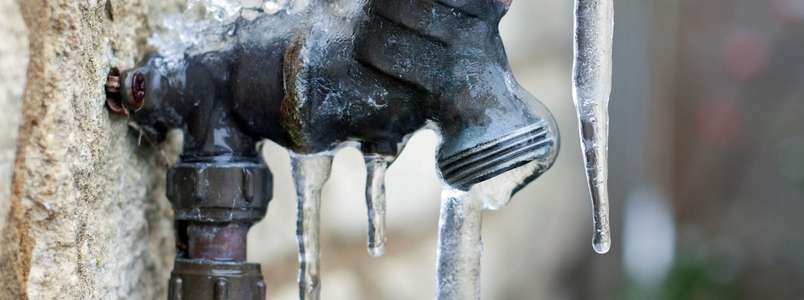
However, if you want to do it yourself, here is the step-by-step process:
Step 1: Drain the Pipe
The first step of frozen pipe repair is to turn off all water sources and then drain the pipe by turning on a faucet near where it exits from your home. This will help to release the ice that has formed inside the pipe.
Be sure to drain all the way from the point of entry to where the pipes exit your home so that any remaining ice can be cleared away.
Step 2: Insulate the Pipe
Next, insulate any exposed pipes that you find as well as any pipes in unheated areas of your home such as attics or crawl spaces with foam insulation wrap. This will help to keep the pipes from freezing again in the future.
Keep a keen eye on the temperature outside and make sure the insulation wrap is adequate for your climate. Once the pipe is insulated, you can turn the water back on and test to see if it is flowing properly.
Step 3: Thaw the Pipe
Lastly, use heat from an electric space heater or hair dryer to thaw out the frozen pipe; this should only be done if there are no other alternatives. Be sure to use a thermometer to monitor the temperature as you work.
Once the pipe has been thawed, make sure all water is running properly and that no additional freezing occurs. If not, call a plumber and have them come to inspect your pipes.
Now you have known the easy, conventional steps to make your pipe clear. But surely you want to know more, right? Let’s continue with the detailed and more ways for your hassle-free solution.
Frozen Pipe Repair 101: Home Remedies
There are some home remedies you can follow to deal with your frozen toilet drain pipe/ kitchen pipes. The easiest of them goes something like this:
If you have a space heater, point it at the pipe and wait for a few minutes to let the heat penetrate. This is an effective way to thaw out frozen pipes; however, you must be careful when using space heaters, as they can present fire risks if not used properly.
If you don’t have a space heater, fill a hot water bottle or electric heating pad with warm (not boiling) water and wrap it around the affected pipe.
Change out the water periodically to keep the heat up over a period of time until you notice the water starting to flow through the pipe. This can take anywhere from a few hours to a day or more depending on how much of the pipe is frozen.
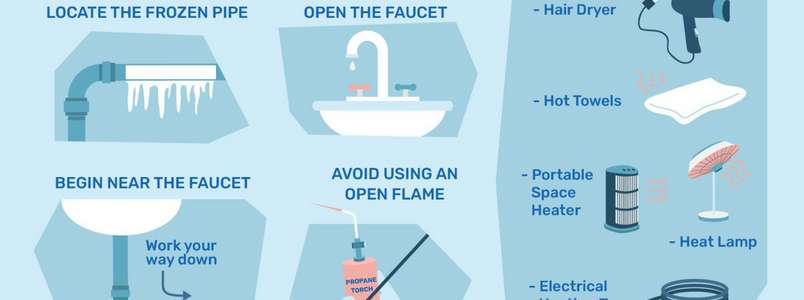
If you don’t have either of these items, then create layers of insulation with thick towels around the affected pipe before pouring hot water over it directly. Again, do this periodically until you notice the water starting to flow.
These home remedies can often be enough to fix a frozen pipe; however, if your attempts do not succeed then it is important to call a plumber right away.
Plumbers have the tools and expertise needed to take care of this problem safely and quickly. Plus, they will be able to identify the cause of the problem (such as improper insulation) and help prevent it from happening again. Frozen toilet drainpipes can also be cured in this way.
It is important to note that a frozen pipe can burst if not treated, resulting in damage to your property and costly repairs. So if you suspect your pipes may be frozen, take action right away!
Do Frozen Pipes Always Burst?
So, what happens when pipes freeze? Do they always burst?
The answer is that frozen pipes can, in fact, burst. When a pipe freezes, the water inside begins to expand as it turns into ice.
This expansion puts tremendous pressure on the walls of the pipe, which can eventually cause it to rupture if left unchecked. A broken or leaking pipe can lead to extensive
However, the truth is that frozen pipes can be prevented with some simple precautions, and the chances of them actually bursting are slim if you take good care of them.
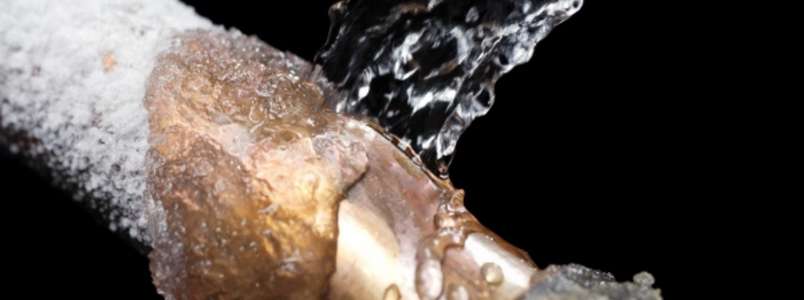
Here are some tips to help keep your pipes from freezing during colder months:
1. Insulate exposed pipes with foam insulation or similar materials to keep them from getting too cold.
2. Disconnect and drain outdoor hoses during the winter season, as water left in them can freeze and cause problems when temperatures drop.
3. Keep your home at a consistent temperature throughout the colder months – this will help keep pipes from freezing.
4. If it gets too cold and pipes do freeze, never try to thaw them with an open flame. This can cause a dangerous situation. Instead, use a hair dryer or hot water bottle to slowly and gently thaw the pipe.
Read this Forbes article if you are still unsure about what to do with broken pipes caused by freezing.
How Much Does It Cost To Repair Frozen Pipes?
Now the question is when there is an active recession and war ongoing, how much does it cost to repair frozen pipes? Follow along to find out!
A standard 3/4 inch diameter costs about $50 per foot, but the average cost to repair is about $400. The average cost to repair frozen pipes differs depending on many different factors such as location, length, and thickness of the pipe, as well as the type of materials used.
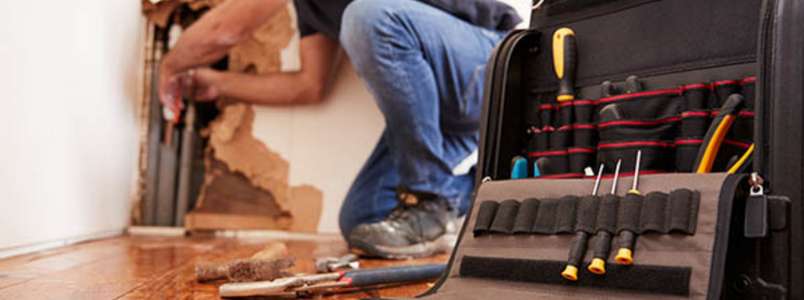
A 3/4 inch diameter tube would normally run around $50 per foot but could see a price ranging from $100 to up to $2000 depending on these circumstances.
What does that mean? It means that frozen pipes can be a very expensive problem. If you live in an area that is prone to freezing, you may want to take steps to prevent the pipes from freezing.
To keep your pipes from freezing, you should insulate them with foam or pipe wrap insulation. This will help prevent the cold air from getting into your pipes and causing them to freeze.
You can also take other precautions such as using heat tape on water lines that are exposed to the elements and moving outdoor faucets away from anything that might cause cold air to blow on them.
How to Repair Frozen Pipes: Pro Tips
Many people want to know how to repair frozen pipes at home in an easier way. Here are the solutions you can apply at home:
1. Heat application: In common, to get rid of the frozen state of your pipe first you need to set the temperature higher. So you should Apply heat to the section of the pipe that is frozen.
1. Wrapping: This can be done by wrapping an electronic heating pad around the pipe, heating the area with a hair dryer, or both. If you lack either of these items, using towels soaked in hot water will help as well.
2. Running water process: Running water through the pipe, as cold as it is, will help melt ice in the pipe. Apply heat to the section of the pipe using an electric heating pad wrapped around the pipe, an electric hair dryer, or a portable space heater (kept away from flammable materials), or wrapping pipes with towels soaked in hot water.
3. Thaw with a hot gun: If the pipes are frozen but have not burst, a plumber can remedy them by applying a heat gun to thaw them. For an interim solution, a homeowner could use a hair dryer to start the thawing process.
Basically, A plumber’s main role and concern in this situation are to identify and fix the problem that caused the pipes to freeze.
But what if it’s extremely low temperature and you are not able to do anything, or you are out of your house? You should only follow the steps below for early remedy:
- First, Turn off the water supply
- Immediately you should call a plumber
- Take a picture and document all the damages
- Dry the area as soon as possible
- Call your insurance company if a large area is affected
Frozen toilet drain pipes, and kitchen pipes cause unnecessary complications in your daily life. To avoid such hassles you’ll need to maintain your plumbing system regularly. Let’s see how to deal with your frozen kitchen pipe and frozen toilet drain pipes. Read this article to avoid frozen pipes in winter.
Frozen Toilet Pipes What To Do
Setting up new pipes every week isn’t practical for anyone. As frozen pipes are an obvious issue, you need to be prepared for it. Here’s how to deal with frozen pipe repair in the toilet:
1. Start by turning off the main water supply to the toilet: This will prevent any further damage from occurring if you are unable to thaw out the pipe in time.
2. Protect yourself with safety gear: Make sure you wear gloves and goggles during this process to protect yourself from any potential danger.
3. Locate and inspect the pipe: Identify where the frozen section of the pipe is located. If it is near the wall of your home, then you may need to cut through some drywall to get to it.

4. Heat the pipe: Use a space heater or hair dryer to apply heat directly to the frozen section of the pipe. This should help thaw out the area and will allow water to flow again.
5. Wrap the pipe: Once you have thawed out the frozen area, immediately wrap it in insulation or heat tape. This will help keep the area from freezing again in the future.
6. Turn on the main water supply: After wrapping the pipe with insulation or heat tape, turn on the main water supply to make sure everything is working properly. Some useful tips on thawing frozen water pipes by the State of Maine
How To Prevent Pipes from Freezing
Prevention is always better than cure. It is much easier to prevent pipes from freezing than it is to thaw them out. The following are ways you can protect your pipes from freezing temperatures:
1) Insulate Your Pipes – Wrapping insulation around the pipes in cold areas of a home can help keep the temperature of the pipe above freezing. Make sure that all exposed pipes, as well as those in unheated areas, like basements and attics, are properly insulated.
2) Install Heat Tape – Heat tape is a type of electric heat cable that can be wrapped around pipes to keep them from freezing. This type of insulation should be installed by a professional electrician.3) Keep Cabinet Doors Open – Keeping the cabinet doors open in your kitchen and bathroom can help warm air circulate around the pipes to prevent them from freezing. Make sure to close any windows near these areas as well, so cold air doesn’t come in.
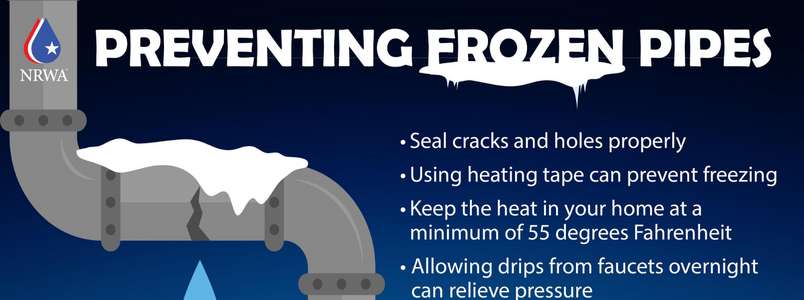
4) Let Faucets Drip – Allow a small trickle of water to flow through the faucet during freezing temperatures. This can help keep the water moving in the pipes and prevent them from dropping below freezing.
5) Seal Drafts – Make sure to seal any cracks or drafts around windows and doors that may be letting cold air into your home. This will help keep the temperature of your house consistent and reduce the chance of your pipes freezing. Here is how the government of Massachusetts deal with frozen pipes.
Epilogue
Thanks for reading this far. In this guide, We’ve tried to provide a general overview of the frozen pipe repair process. That said, every home and plumbing system is different, so it can be slightly different for you, but some principles are the same.
We’ve tried to answer questions like, why pipes freeze, how to fix them yourself, do frozen pipes always burst, and how to protect pipes from freezing, Hope that information proves to be helpful to you in the long run.
If you want to deal with your frozen pipe issue all by yourself, you’re most welcome to try. However, if you’re looking for a reliable and professional plumbing services, we are here to help.
With our seasoned professional and industry-best practices, we can help you with any frozen pipe repair and maintenance needs quickly, efficiently, and cost-effectively. Our 24 hour plumber services also include home renovation plumbing, general plumbing, pool installation, and many more.
Contact us today for further information and to get started. We look forward to hearing from you!






 by
by